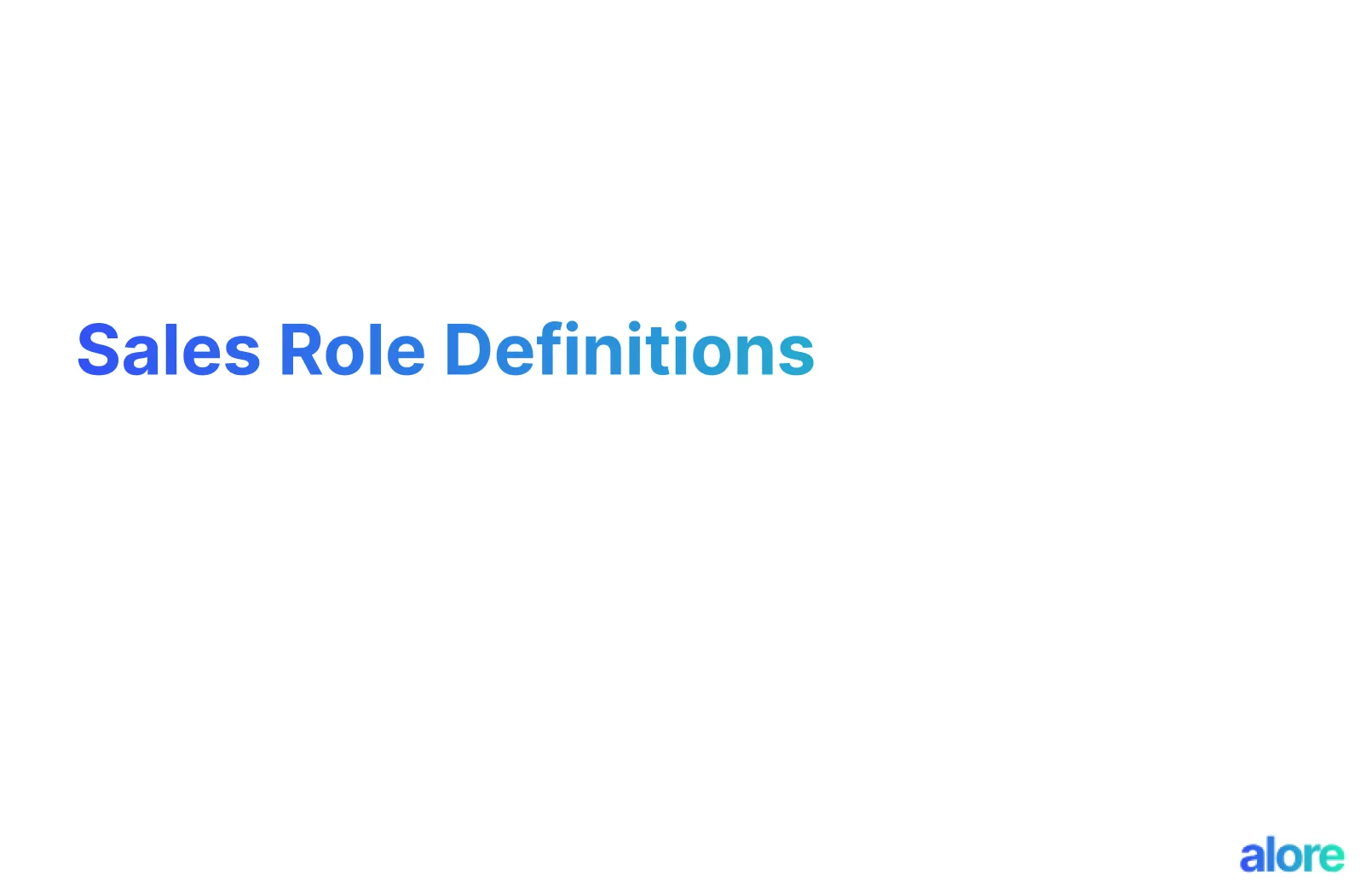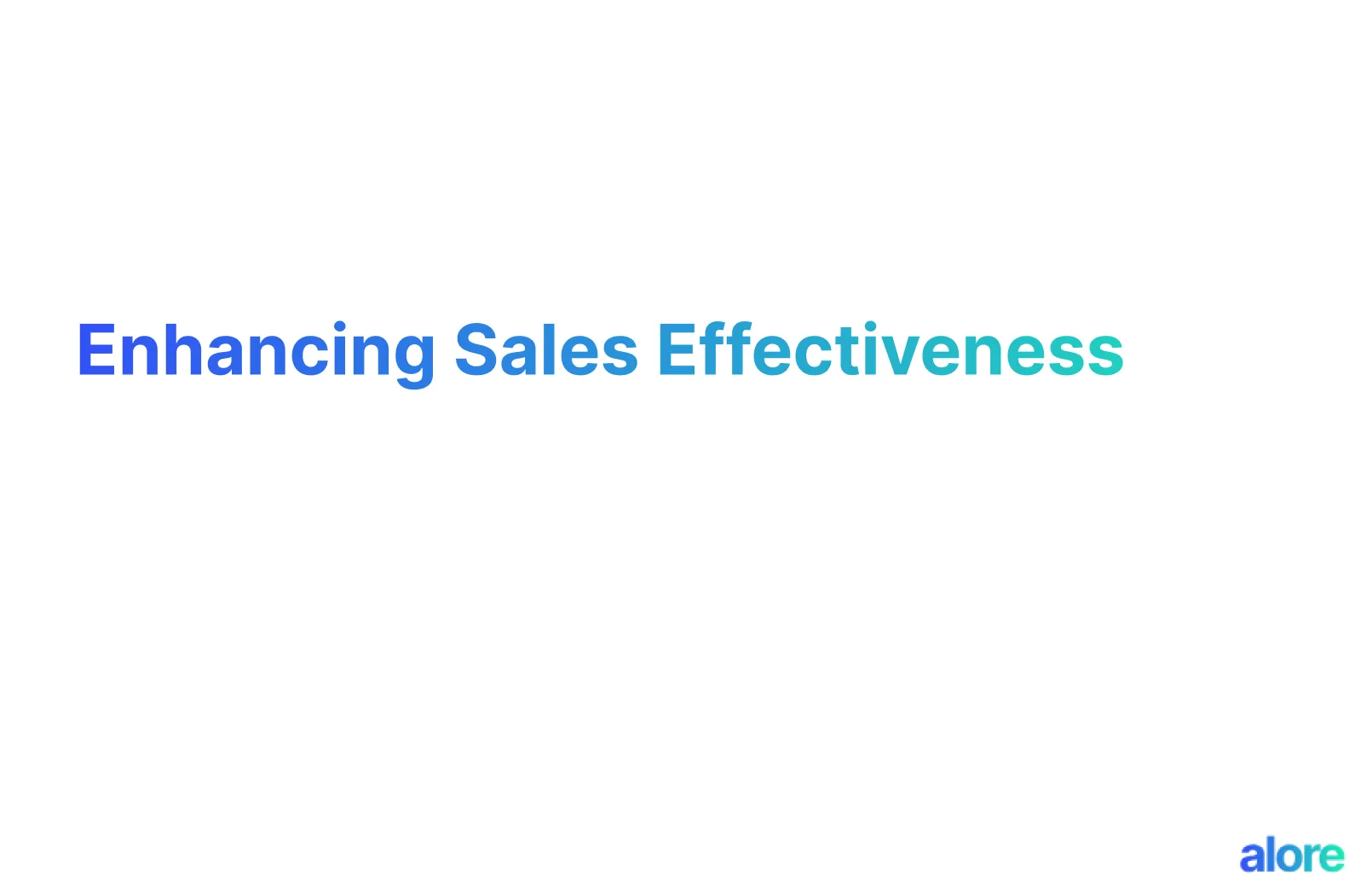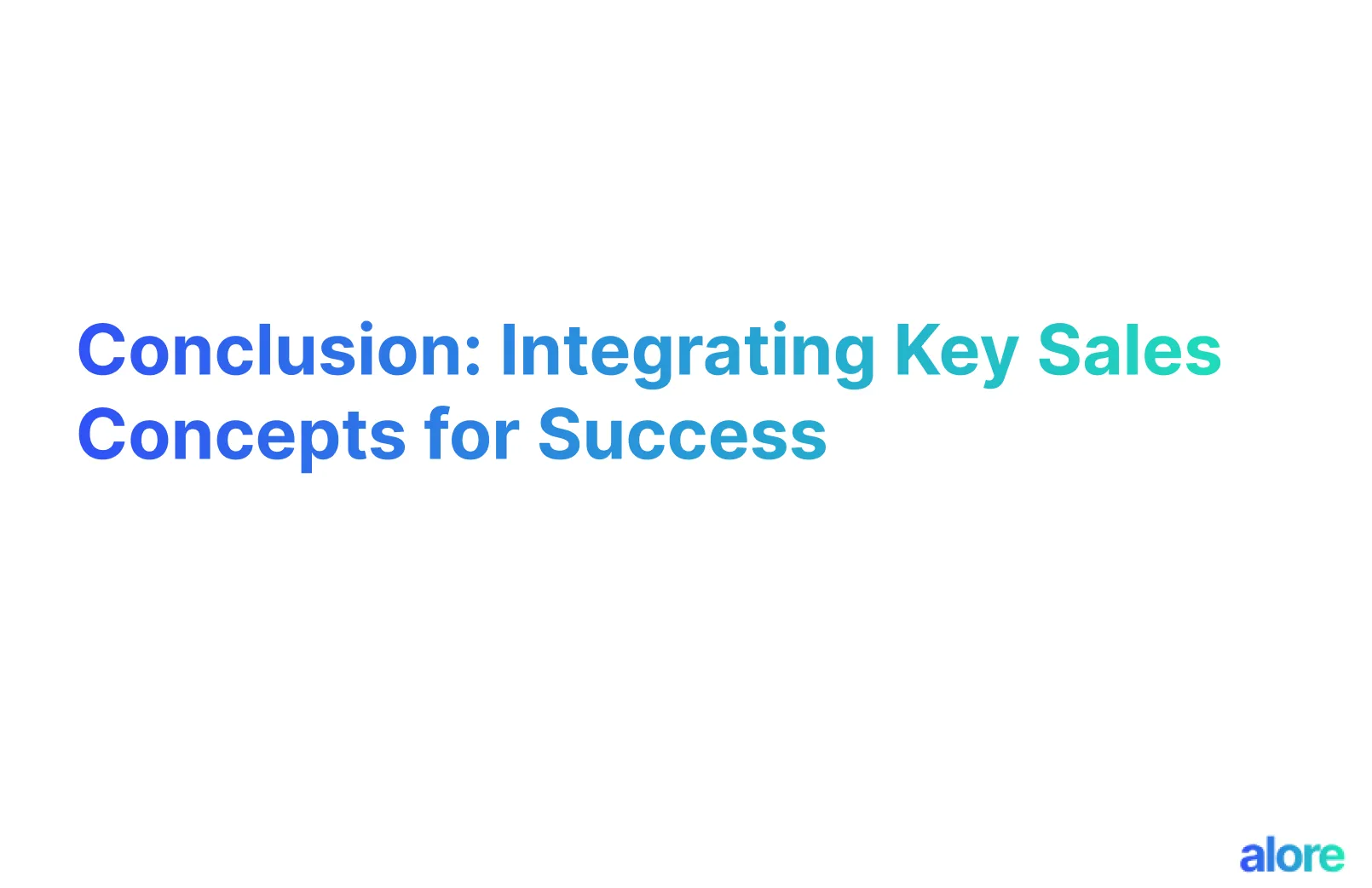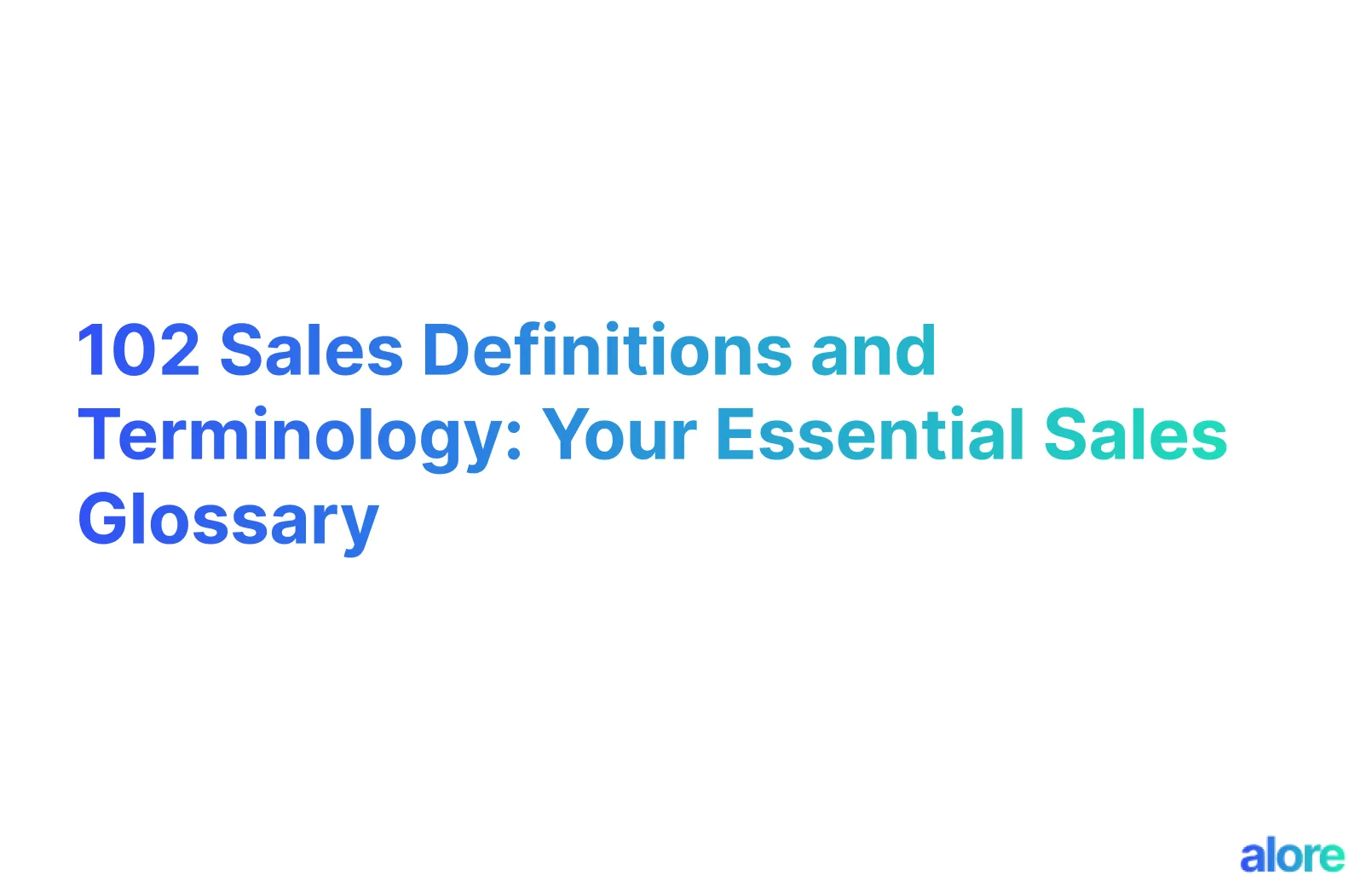Introduction: Navigating the World of Sales Definitions
Sales terms and terminology are more than a collection of words; it's the backbone of effective business communication and strategy.
This section unpacks the essential role of sales terms and definitions in professional environments.
The Role of Sales Terminology in Effective Business Communication
Sales definitions are not just terms but the building blocks of successful sales and marketing strategies. Let's break down their significance:
- Aligning Teams: In a meeting where one group discusses "Lead Qualification" and another talks about "Conversion Rates," clear definitions ensure everyone is on the same page. This shared language is crucial for aligning goals across departments, especially in B2B and B2C settings.
- Strategic Decision Making: Understanding terms like "Prospect" versus "Qualified Lead" can significantly influence your sales approach. Such clarity in terms helps in accurately targeting potential customers and efficiently allocating resources.
- Adapting to Evolving Strategies: As sales strategies evolve, so does the terminology. Grasping modern terms like "CRM" (Customer Relationship Management) or "ARR" (Annual Recurring Revenue) equips professionals with the knowledge to leverage these tools effectively.
- Training and Development: A solid grasp of sales terminology is vital for new sales reps. It forms the foundation for effective communication within teams and with clients.
- Client Communication: Explaining concepts like "Customer Lifetime Value" or "Churn Rate" in simple terms can help in establishing credibility with clients. This not only educates but also demonstrates the salesperson's expertise.
- Internal and External Clarity: Clear communication using well-understood sales terms helps avoid misunderstandings, and fosters trust internally among team members and externally with clients.
In essence, mastering sales definitions is a crucial step toward professional growth in sales. It's not just about learning terms but understanding their application in real-world scenarios.
This journey through sales terminology is an opportunity to deepen your understanding and enhance your effectiveness in the sales domain.
Core Sales Terms

Sales
The concept of 'sales' is the cornerstone of every business. It's the process that starts with identifying a potential customer and ends more with sales than just the transaction.
It involves understanding customer needs, presenting solutions, and building relationships that lead to successful business outcomes. The art of sales lies in persuading a potential buyer (or a 'Lead', as we'll discuss shortly) that your product or service meets their needs and provides significant value.
Lead
A 'Lead' is someone who has shown interest in your product or service. Think of leads as the seeds of potential sales. Identifying and nurturing leads is crucial, as it sets the stage for the entire sales process. But not all leads are created equal. Some may require more nurturing than others, and this is where the skill of identifying the right leads – those most likely to convert into sales – becomes invaluable.
Prospect
A 'Prospect' takes the concept of a lead a step further. This is someone who has shown interest and is evaluated as a potential customer. Prospects are often assessed through specific criteria such as their ability to purchase, their authority to make buying decisions, and their suitability for the product or service offered. Distinguishing between leads and prospects is a vital step in streamlining the sales process.
B2B (Business-to-Business)
In the B2B model, transactions happen between businesses. This environment is characterized by longer sales cycles, higher order values, and more decision-makers involved in purchasing. Understanding B2B sales is about grasping the complex dynamics of these transactions, where relationship-building and in-depth knowledge of the client's business needs are paramount.
B2C (Business-to-Customer)
B2C sales involve transactions between a business and individual consumers. This model often sees quicker decision-making, more emotional buying behavior, and a greater focus on marketing and customer service. Excelling in B2C sales requires understanding consumer behavior and creating compelling marketing messages that resonate with a broad audience.
Sales Rep
The term 'Sales Rep' (or sales representative) refers to an individual who represents a company and is responsible for selling its products or services. A good sales representative is not just an expert in their product; they are skilled communicators, adept at understanding customer needs, handling objections, and closing deals.
Sales Team
A 'Sales Team' is a group of individuals working together to achieve sales goals.
This team can include sales reps, account managers, business development personnel, and sales support staff. The effectiveness of a sales team hinges on its ability to collaborate, share insights, and collectively drive sales strategies forward.
Sales Process
The 'Sales Process' is a set of repeatable steps a sales team takes to move a potential or buyer's journey from the early stage of awareness to a closed sale. Understanding and optimizing the sales process is key to a team's success. It involves stages like prospecting, qualifying leads, presenting offers, and closing deals. A well-defined sales process helps in forecasting sales and managing sales activities efficiently.
Sales Metrics and KPIs

This section dives deep into the critical sales metrics and KPIs every sales professional should have on their radar.
Let's break them down:
Annual Recurring Revenue (ARR)
ARR is a cornerstone metric in businesses with subscription-based models.
It represents the predictable and recurring revenue components of your business, typically calculated on an annual basis. For instance, if you have 100 customers, each paying a monthly subscription of $100, your ARR would be $120,000.
Monitoring ARR is essential for forecasting and growth planning, especially for companies in the SaaS and subscription sectors.
Monthly Recurring Revenue (MRR)
MRR, a close relative of ARR, measures the total predictable and recurring revenue in a month.
It's a vital metric for understanding the month-to-month health of your business.
By tracking MRR monthly recurring revenue, businesses can quickly gauge their financial stability and recurring income stream, making it easier to plan and allocate resources effectively.
Customer Acquisition Cost (CAC)
Customer Acquisition Cost, or CAC, is the cost of winning a customer to purchase a product or service. It encompasses the total sales and marketing expenses over a specific period, divided by the number of customers acquired in that period.
For example, if you spent $10,000 on marketing in a month and acquired 100 customers, your CAC is $100.
A lower CAC indicates a more efficient sales and marketing operation.
Customer Lifetime Value (CLV)
Customer Lifetime Value, or CLV, predicts the total value a business can expect from a single customer account.
It considers a customer's revenue value and contrasts it with the company's predicted customer lifespan.
Businesses aim to increase CLV by enhancing customer experience and fostering long-term relationships.
Higher CLV means customers are staying longer and spending more.
Key Performance Indicators (KPIs)
Key Performance Indicators or KPIs in sales are metrics that indicate the performance and success of sales activities.
Examples include the number of new sign-ups, the average deal size, and the sales cycle length. Effective sales teams closely monitor these indicators to measure their progress toward sales goals and adjust strategies as needed.
Net Promoter Score (NPS)
Net Promoter Score or NPS measures customer experience and predicts business growth.
It's obtained by asking customers how likely they are to recommend your product or service to others on a scale of 0-10. Scores of 9-10 are 'Promoters,' 7-8 are 'Passives,' and 0-6 are 'Detractors.'
NPS is a potent gauge of customer satisfaction and loyalty.
Profit Margin
This metric shows the profitability of a product, service, or business.
It's calculated by subtracting the cost of goods sold from sales revenue, divided by revenue.
High-profit margins indicate that a company is efficient in its operations and well-positioned for growth.
Sales Strategy Terms

This section provides an in-depth look at various sales strategy terms, underpinning their importance in crafting successful sales tactics. Let’s explore each one:
Account-Based Selling
Account-based selling focuses on targeting specific high-value accounts, a strategy especially relevant for sales teams and sales reps in B2B contexts.
Instead of a broad, generalized approach, ABS emphasizes tailored solutions and personalized engagement, making it a cornerstone in an effective sales process.
BANT Framework
The BANT Framework, standing for Budget, Authority, Need, and Timeline, is a guide for sales reps to qualify leads.
It helps determine whether potential customers have the financial resources (Budget), decision-making power (Authority), a genuine need for the product (Need), and an appropriate timeline for purchase (Timeline).
This framework is vital in the overall sales strategy, streamlining the sales pipeline and enhancing the effectiveness of the sales process.
Cold Calling
Cold Calling, a traditional yet challenging sales call strategy, involves sales representatives reaching out to potential customers without prior contact with paying customers.
It’s a direct sales technique requiring skill and persistence, which is crucial to the sales and marketing teams' efforts to expand their customer base.
Cross-Selling
Cross-selling is a tactic used by sales teams to offer additional, complementary products or services to existing customers, thus enhancing customer relationship management (CRM) efforts.
It’s a strategy aimed at increasing the overall value of sales by tapping into the existing customer base.
Direct Sales
Direct Sales refers to selling products or services directly to consumers, bypassing intermediaries.
This method allows sales reps to build a direct relationship with customers, offering personalized experiences and in-depth product demonstrations.
Discovery Call
A Discovery Call is an initial conversation where sales reps engage with a potential customer to understand their needs.
This step in the sales process is crucial for identifying the potential for a sales qualified lead, setting the stage for a successful sales strategy.
Value Proposition
The Value Proposition clearly explains how a product or service solves a customer’s problem or improves their situation.
It’s a key element in the sales and marketing strategy, essential for persuading potential customers of the unique benefits of a product or service.
Upselling
Upselling is a technique where sales representatives encourage customers to purchase higher-end products or additional features.
It’s an integral part of the sales process, aiming to increase the average transaction size and drive sales revenue.
Sales Role Definitions

Various roles play critical parts in the success of a business. Understanding these roles is key to appreciating how sales strategies are executed. Let's delve into some crucial sales roles and their definitions:
Account Development Representative
An Account Development Representative (ADR) focuses on growing existing customer accounts.
Their role involves a sales development representative identifying opportunities within current client relationships for upselling or cross-selling.
Unlike the new client and customer acquisition cost side, which is typically the focus of a Business Development Representative, ADRs work to maximize the value of existing customers, a crucial strategy in customer relationship management (CRM).
Business Development Representative (BDR)
A Business Development Representative's primary role is to generate new business opportunities.
They do this by identifying potential buyers, initiating outreach, and nurturing leads through the sales funnel until they are ready for a direct conversation with a sales rep.
BDRs are the spearhead of the sales process, actively engaging in market research and lead qualification.
Sales Development Representative (SDR)
The role of a Sales Development Representative (SDR) overlaps with that of a BDR but with a more laser-focused approach to qualifying leads from marketing campaigns.
SDRs are responsible for the initial contact and qualification of sales leads, handing them off to the sales team once they're deemed ready.
Their work is critical in ensuring the sales pipeline is fed high-quality leads.
Inside Sales Rep
Inside Sales Reps operate remotely, often from a company's office, and sell products or services over the phone or through digital channels.
They are adept at managing sales through emails, phone calls, and video conferencing, making them pivotal in today’s digital sales environment.
The role requires strong product knowledge and the ability to close sales without face-to-face interaction.
Field Sales Rep
Contrastingly, Field Sales Reps are the traditional face of sales, engaging in in-person meetings with clients.
They travel, attend industry events, and participate in face-to-face negotiations, playing a vital role in building strong customer relationships.
Field sales reps often deeply understand the buying process and are skilled in persuasive, direct sales tactics.
Customer Journey in Sales

The customer journey in sales is a pivotal aspect of the sales process. It encompasses various stages and roles, each requiring specific strategies and understanding.
This section breaks down key components of the ideal customer journey, ensuring a comprehensive grasp of what drives successful sales interactions.
Service Level Agreement (SLA)
A Service Level Agreement in sales sets the standard for the service provided, often seen in the context of sales teams and customer success.
It defines the level of service expected, detailing metrics like response times and issue resolution procedures.
SLAs are crucial in managing customer expectations and maintaining high customer service throughout the lifecycle.
Buyer Behavior
Understanding buyer behavior is essential for both sales reps and marketing teams.
It involves studying how potential customers decide to purchase a product or service, including their habits, preferences, and influences.
This insight is critical for tailoring sales strategies and marketing efforts, ensuring they resonate with the target audience.
Buying Criteria
Buying criteria are the set of standards and factors that potential customers use to evaluate and choose a product or service.
These criteria can include price, quality, convenience, and brand reputation. Sales and marketing teams must understand these criteria to position their offerings and meet customer needs effectively.
Consumer
The consumer is the end-user of a product or service. Sales strategies often differentiate between the consumer and the decision-maker, especially in B2B sales, where the person using the product may not be the one making the purchase decision. Understanding the consumer is key to tailoring sales presentations and marketing materials.
Decision-Maker
The decision-maker is the person with the authority to make the purchase decision.
Identifying and engaging with the decision-maker in the sales process is crucial for closing sales. Sales representatives must understand the decision-makers needs, pain points, and buying process to communicate the value proposition effectively.
Middle of the Funnel (MOFU)
MOFU refers to the stage in the sales funnel where potential customers are considering their options.
At this stage, the marketing qualified lead or leads may turn into sales or marketing qualified lead leads. Sales reps and marketing teams work together to nurture these leads by providing detailed information, addressing concerns, and showcasing the product's or service's benefits.
Top of the Funnel (TOFU)
TOFU is the initial stage of the sales funnel, where potential customers first become aware of a product or service.
It's a crucial stage for lead generation efforts, as sales and marketing teams aim to attract as many potential buyers as possible and convert them into leads through various strategies like content marketing, social media campaigns, and cold calling.
Opportunity
An opportunity in sales is a qualified lead with a high conversion potential.
Sales teams track these opportunities through the sales pipeline, employing strategies to move them toward a successful sale.
Recognizing and effectively managing opportunities is a key skill for any sales representative.
Customer Success
Customer success is a function dedicated to ensuring customers achieve their desired outcomes while using the product or service.
It's an integral part of the post-sales process, emphasizing customer retention and satisfaction.
Customer success teams work closely with sales representatives to understand customer needs and ensure a smooth transition from potential buyers to loyal customers.
Sales Software and Technology

Sales software and technology are not just tools but are integral components of a comprehensive sales strategy.
This section explores key technologies that are reshaping the sales process and how sales teams engage with potential and existing customers.
CRM (Customer Relationship Management) Systems
CRM Systems are crucial in managing customer relationships and sales processes. They provide sales representatives with a unified platform to track interactions, manage sales pipelines, and analyze customer data. This technology is instrumental in enhancing customer lifetime value and streamlining the sales cycle.
Cloud-Based CRM
The advent of Cloud-Based CRM has revolutionized how sales teams operate, offering unparalleled flexibility and accessibility.
This innovation allows sales reps and sales teams to access critical data anytime, anywhere, facilitating real-time decision-making and responsiveness to market dynamics.
CPQ (Configure, Price, Quote) Software
CPQ Software is a game-changer in complex sales processes, particularly when dealing with diverse products or services.
It aids sales representatives in quickly generating accurate quotes, addressing a critical component of the sales funnel and ensuring a smooth buying process for potential customers.
Lead Management
Effective lead management is essential in converting prospects into paying customers.
Lead Management tools help sales and marketing teams identify and nurture leads, guiding them through the sales funnel.
These tools are crucial in qualifying leads, a fundamental step in the sales process.
Sales Dashboard
Sales Dashboards are vital for sales teams to monitor key performance indicators and sales revenue.
They provide a comprehensive view of sales activities, helping teams to track progress and adjust sales strategies in real time.
This tool is essential for sales reps to stay informed and agile.
Business Intelligence
Incorporating Business Intelligence in sales allows for data-driven strategies and informed decision-making.
It enables sales teams to identify trends, understand customer needs, and anticipate future sales.
This approach is crucial for targeting the ideal customer and optimizing the product or service offered.
Sales Pipeline and Funnel Management

Understanding and managing the sales pipeline and funnel is crucial for the success of sales teams in any organization. This section delves into the complexities of pipeline and funnel management, using sales definitions to clarify each concept.
Sales Pipeline
The sales pipeline visually represents where prospects are in the sales process. It's a vital tool for sales reps and sales teams to track progress and forecast future sales.
Each stage of the pipeline reflects a step in the buying process, from initial contact to closing the deal. Effective pipeline management helps in identifying bottlenecks and improving the overall sales strategy.
Sales Funnel
The sales funnel is a broader concept that encompasses the entire journey of a potential customer.
It starts from the top of the funnel (TOFU), where awareness is created, to the bottom of the funnel (BOFU), where sales are closed.
The funnel is essential for understanding the flow of marketing qualified leads (MQLs) and sales qualified leads (SQLs), guiding marketing and sales teams in nurturing leads effectively.
Weighted Sales Pipeline
A weighted sales pipeline assigns values to each stage of the pipeline based on the probability of the deal closing.
This approach gives sales teams and representatives a more accurate picture of potential revenue and helps in prioritizing efforts on leads with a higher chance of conversion.
Lead Generation
Lead generation is the process of attracting potential customers (leads) into the sales funnel.
It involves various tactics like content marketing, direct sales, and cold calling.
The goal is to convert these leads into MQLs, ensuring a continuous supply of prospects for the sales process.
Lead Qualification
Lead qualification is the process of assessing whether a lead is likely to become a paying customer.
This step is crucial for sales representatives to focus their efforts on leads with the highest potential, optimizing the sales cycle and resources.
Marketing-Qualified Lead (MQL)
An MQL is a lead deemed more likely to become a customer than other leads based on specific criteria set by the marketing team.
These leads are nurtured through marketing efforts until they are ready to be handed over to the sales team.
Sales Qualified Lead (SQL)
An SQL is a lead that has been evaluated and approved by the sales team as a potential customer. These leads have moved further down the sales funnel and are closer to making a purchase.
Pipeline Management
Effective pipeline management involves tracking and managing the progress of leads through the sales pipeline. It requires the coordination of sales teams, the use of CRM software, and a clear understanding of potential customers' sales process and buying criteria.
Buying Process
The buying process is the journey a potential customer goes through before making a purchase.
It includes recognizing a need, researching solutions, evaluating options, and finally making a decision. Sales teams must understand this process to align their sales strategies and close deals effectively.
Advanced Sales Concepts

Profit Margin
Profit margin is a critical financial metric in sales, representing the percentage of revenue that exceeds the cost of goods sold.
It is essential for sales reps and sales teams to understand and maximize profit margins to ensure the financial health and success of the business.
Profit margins are not just numbers; they reflect the efficiency of sales strategies and tactics.
Quota
A sales quota is a target set for sales representatives or teams to achieve within a specific period.
Quotas are often tied to sales revenue or units sold and are crucial in sales performance management.
They serve as benchmarks for measuring success and incentivizing sales reps, playing a vital role in driving sales strategies.
Sales Performance Management
Sales performance management encompasses the strategies, processes, and tools to enhance sales effectiveness.
It includes setting goals, tracking progress, and implementing sales tactics that align with the company's overall sales strategy.
Effective, sales rep performance management is key to aligning sales reps' efforts with business objectives.
Sales Strategy
A sales strategy is a plan devised to achieve sales goals and targets.
It encompasses various elements, including market research, targeting potential buyers, and choosing the right sales tactics.
Sales strategies are dynamic and must evolve with market changes, customer preferences, and competitive landscapes.
Sales Tactics
Sales tactics are the specific methods used to execute a sales strategy.
These can range from direct sales approaches to more nuanced methods like consultative selling.
Sales tactics must be tailored to potential customers' buyer persona and buying process to be effective.
Sales and Marketing Alignment
Aligning sales and marketing teams is critical for seamless lead generation and qualification processes.
This alignment ensures that marketing efforts effectively support sales by providing high-quality leads, such as marketing-qualified leads (MQLs) and sales-qualified leads (SQLs), which are crucial for the sales pipeline.
Market Research
Market research is indispensable for understanding the target audience, including potential buyers and their buying criteria.
It informs the development of buyer personas, helping sales and marketing teams tailor their strategies and communications to meet customer needs and preferences.
Buyer Persona
A buyer persona is a semi-fictional representation of an ideal customer based on market research and real data.
Understanding the buyer persona helps sales reps and teams personalize their sales tactics and communication, making the sales process more efficient and effective.
Qualified Lead
A qualified lead refers to a potential customer who has been assessed and meets certain criteria, making them more likely to purchase.
The lead qualification process involves evaluating leads based on their fit with the product or service offered and their likelihood to buy, which is crucial for efficient pipeline management.
Enhancing Sales Effectiveness

This section delves into essential strategies and practices that can significantly enhance the effectiveness of sales efforts.
Sales Enablement
Sales enablement empowers sales reps with essential tools and information, integrating key aspects like CRM software and sales strategies.
This comprehensive approach ensures that sales teams have everything they need, from product knowledge to understanding the buyer's journey, to engage potential customers effectively.
Sales Presentations
Effective sales presentations are pivotal, especially when addressing the annual contract value and demonstrating value propositions.
They should be tailored to the buyer's journey, focusing on addressing pain points with clear, data-backed solutions.
A well-crafted presentation can significantly improve conversion rates and drive sales revenue.
Sales Script
A well-prepared sales script helps representatives navigate customer interactions, from initial discovery calls to closing sales.
It’s a strategic tool in objection handling, ensuring that reps are ready to address common concerns, especially when discussing annual contract values or forecasting future sales.
Objection Handling
Objection handling is an art that requires understanding the buyer persona and anticipating potential hurdles. I
t’s about addressing concerns regarding product or service offerings and clearly demonstrating how these meet the customer's needs, thereby improving the sales cycle efficiency.
Pain Point
Identifying and solving the customer's pain points is at the heart of sales effectiveness. This involves thorough market research and applying insights to tailor sales tactics. and pain points. By understanding and addressing these pain points, sales teams can enhance their strategies and drive meaningful engagement.
Positioning Statement
The positioning statement is crucial for aligning sales and marketing efforts. It succinctly communicates the unique benefits of a product or service, ensuring that marketing and sales teams together are equipped to convey this message effectively throughout the sales process and particularly during sales presentations.
Commission
Commission structures are essential in motivating sales teams, directly impacting sales tactics and strategies. They incentivize reps to focus on high-priority areas like boosting the annual contract value and improving the weighted sales pipeline.
Conversion Rate
The conversion rate is a vital metric, offering insight into the effectiveness of sales strategies and tactics.
It involves understanding the sales funnel dynamics and optimizing each stage, from lead generation to closing, ensuring that potential customers are effectively converted into paying customers.
Forecasting
Accurate sales forecasting is critical for effective sales performance management.
It involves analyzing past sales data, understanding current market trends, and predicting future sales, including estimating annual recurring revenue (ARR) and monthly recurring revenue (MRR).
This foresight is crucial for planning and resource allocation.
Miscellaneous: Diverse Sales Concepts

Annual Contract Value (ACV)
ACV refers to the value of a contract over a year.
In sales, it's often used to gauge the worth of a long-term agreement with a customer.
ACV is vital for forecasting revenue and determining the financial stability provided by annual contracts.
Challenger Sales Model
This sales model is based on the concept of teaching, tailoring, and taking control of sales conversations.
The challenger approach involves understanding the customer's business, challenging their thoughts, and offering innovative solutions.
Customer Accounts
Customer accounts refer to the business relationships a company has with its clients.
Managing these accounts involves nurturing ongoing relationships, understanding client needs, and ensuring customer success.
Closing Ratio
The closing ratio is a metric that measures the number of successful sales closed compared to the total number of sales opportunities.
A higher closing ratio indicates more efficient sales tactics and a productive sales team.
Social Selling
Social Selling refers to the use of social media platforms by sales professionals to interact directly with their prospects.
It involves sharing content, answering questions, and engaging with potential customers.
The goal is to build relationships and establish trust, ultimately leading to sales opportunities.
Value-Based Selling
Value-based selling is a sales approach that focuses on understanding and reinforcing the value that a product or service brings to the customer.
It's about communicating how a product can solve a problem or improve a situation, emphasizing its benefits and ROI (return on investment).
Sales Forecasting Methods
Sales Forecasting Methods use historical data, market analysis, and trends to predict future sales.
This practice helps businesses plan effectively, allocate resources, and set realistic sales targets. Common methods include qualitative forecasting, time-series analysis, and regression analysis.
Hyper-Personalization in Sales
Hyper-personalization in sales refers to the strategy of creating extremely personalized and tailored experiences for potential customers.
Leveraging data analytics and AI, sales teams can now understand customer preferences and behaviors at an individual level, allowing them to offer highly specific solutions, recommendations, and communication.
Sales Gamification
Sales Gamification is the application of game-design elements in the sales process to motivate and engage sales representatives.
Elements such as scoring systems, competitions, and rewards are used to boost motivation, enhance performance, and make the sales process more engaging and enjoyable.
Consultative Selling
Consultative Selling is a sales approach where the salesperson acts more as an advisor than a traditional sales rep. This method focuses on understanding the customer's needs deeply and offering solutions that best fit those needs rather than pushing a standard sales pitch. It's about building trust and long-term relationships.
Omnichannel Sales Strategy
Omnichannel Sales Strategy involves creating a seamless customer experience across various sales channels, whether the customer is shopping online, by phone, or in a physical store. It emphasizes the integration and coherence of sales and marketing efforts across different platforms to provide a unified customer journey.
Predictive Sales Analytics
Predictive Sales Analytics uses data, statistical algorithms, and machine learning techniques to identify the likelihood of future outcomes based on historical data.
It's about anticipating trends, customer behaviors, and sales results, enabling sales teams to make proactive, informed decisions.
Conclusion: Integrating Key Sales Concepts for Success

As we conclude our comprehensive journey through the diverse landscape of sales definitions and concepts, it's important to reflect on the integration of key terms that shape the sales industry. This final section encapsulates essential concepts yet to be fully explored, tying them into the overarching theme of sales excellence.
The Pivotal Role of Sales Reps
Sales reps stand at the forefront of any successful sales strategy. Their role extends beyond mere selling; it involves building relationships, understanding customer needs, and driving the sales process. Developing their skills and expertise is crucial for achieving sales targets and driving business growth.
Elevating Strategies with CRM Software
In today's digital era, leveraging Customer Relationship Management (CRM) software effectively is non-negotiable. CRM software streamlines sales processes and provides invaluable insights into customer behavior, helping tailor strategies to meet market demands and enhance customer experiences.
Fostering Collaboration
A synergistic relationship between sales and marketing departments is vital. Aligning these teams ensures consistent messaging and strategic unity, enhancing overall effectiveness. Marketing and sales teams working in harmony can significantly boost lead generation and conversion rates.
Continuous Learning and Development
The sales landscape is ever-evolving, necessitating continuous learning and adaptation. Business Development Representatives and Account Development Representatives play a critical role in this evolution, constantly seeking new opportunities and strategies to stay ahead of the curve.
Making Informed Decisions
Key Performance Indicators (KPIs) and the Annual Contract Value (ACV) offer critical metrics to gauge performance and make informed decisions. Understanding these metrics helps in fine-tuning sales strategies and forecasting future trends.
Embracing New Approaches
Innovative methodologies like the Challenger Sales Model have revolutionized sales approaches, focusing on challenging and educating customers rather than the traditional selling tactics. Similarly, embracing CRM software as a tool for customer engagement and sales optimization is crucial for modern sales teams.
Closing the Loop
Finally, the conclusion of the sales process, symbolized by the sales call, is where all strategies and efforts culminate. It's where the understanding of customer pain points, effective use of marketing materials, and strategic sales tactics come into play to close deals successfully.









